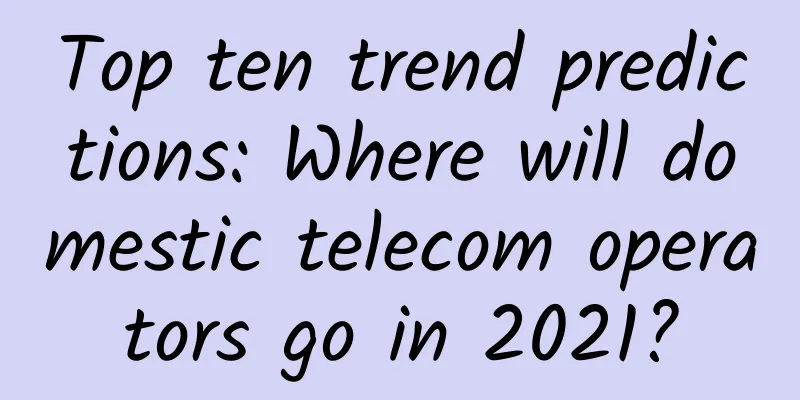Picture | Someone finally explains 5G clearly...

|
The lives of our generation are changing so fast. It seems like dial-up internet access was just yesterday, but today we are entering the 5G era. This article is from "Science Popularization China" and was first published on the "Penguin Science" public account So, what exactly is 5G? And what benefits does it bring to us? What is 5G? The G in 5G is the abbreviation of Generation. To put it simply, 5G means: It is just like the transformation of a mobile phone into a smartphone, the transformation of a DOS system into Win10, and the transformation of a green train into a Fuxing train. It is a major technological upgrade. After 5G is upgraded, it will not only be more powerful than the current 4G, but it will probably be much more powerful than the current 4G and home broadband combined! Therefore, communication service providers around the world are doing their best to make arrangements in advance, hoping to catch up with the 5G express train of major upgrades! So, to be honest, what are the benefits of 5G after it is realized? Three major benefits of 5G From the perspective of ordinary people, 5G has three main benefits:
Let’s talk about speed first. According to an Internet report, even if the world’s fastest 4G speed (Norway, 63 Mb/s on average) and the fastest broadband speed (Singapore, 189 Mb/s on average) are added together, they are still not as fast as 5G (theoretical speed 10,000 Mb/s). With 5G, downloading a 4K movie may only take the time it takes to go to the bathroom. Don't procrastinate. Doing things online is like driving on the road. You can't drive on the highway all the way. The normal process of doing things is to drive on the highway and provincial roads at times. If you are unlucky, you have to go into the city and wait for the red light. So, no matter how fast 4G and broadband seem, you will inevitably encounter lag when playing games or watching videos. This is network latency. With 5G, network delay is basically solved because the network delay of 5G is about 1 millisecond. What is 1 millisecond? It is one thousandth of a second. No matter how many lanes a highway has or how fast the cars travel, it cannot handle the peak traffic during the Spring Festival travel rush. By the same token, when we are taking the subway, shopping in a mall, or watching a game, we always find that either we can’t connect to 4G at all, or we can connect but can’t post to Moments. This is because there are too many mobile phones around you and they are too dense. Everyone is using their phones to crowd out the network. With 5G, even if 100,000 people watch a football match together, the network will not be overwhelmed because 5G can allow 1 million devices to access the Internet at the same time per square kilometer. Of course, 5G's three major benefits of fast service, no delays, and no overcrowding are not only to improve the existing Internet experience. With these three major benefits, it can also achieve greater ambitions! Three major ambitions of 5G The three major ambitions of 5G are actually to deal with three technologies that have been touted for a long time but have never been implemented: VR (virtual reality), autonomous driving, and the Internet of Things. Let’s talk about VR (virtual reality) first. To play VR well, the images must be realistic, otherwise it can only be called a virtual Windows screensaver. Also, if the network delay is too severe, the person wearing the VR helmet will feel dizzy. Therefore, if you want to play VR anytime and anywhere, you must first use 5G. Let's talk about autonomous driving. For example, no matter how powerful the current car's autonomous driving system is, its camera can only see a small section of the road. If a large truck, a curve, or a ramp blocks its view, the car may be in danger. To solve this problem, the car's autonomous driving system must be online at all times, and the data it receives must be received without delay. Therefore, if you want to drive without a driver’s license, you must use 5G first. *** Let's talk about the Internet of Things. The so-called Internet of Things means that not only your mobile phone, VR and car can access the Internet, but also your TV, air conditioner, refrigerator, bathroom heater, flower pot, door lock, and even the fruits, vegetables, beef and salmon you eat can access the Internet during the production, processing and transportation process. As we all know, the concept of the Internet of Things has been proposed for many years. One of the important reasons why it has not been realized is insufficient network capacity. Therefore, if you want to connect even flower pots to the Internet, you must first use 5G. So, how can we make 5G really powerful, instead of being just a hype but never landing like the other three technologies? How to build 5G? To build 5G, it will take more than just one or two small inventions and innovations. From a technical perspective, 5G is a comprehensive innovation of the existing mobile communication system. We use five examples to illustrate, which are multiple antennas, wide roads, complete color numbers, dense sites and accurate aiming. Multiple antennas 5G, like other G generations, uses electromagnetic waves to transmit information. However, the wavelength of 5G signals is shorter than that of other signals, at the millimeter level. The shorter the wavelength, the shorter the antenna. With shorter antennas, one device can have multiple antennas at the same time. This ensures that 5G devices can send and receive multiple groups of signals at the same time. This is called massive multiple-input multiple-output technology (massive MIMO). Road width Since the frequency range of 5G signals is 28~39 GHz, it can allocate a 400 MHz wide road to each channel of information, which is 20 times wider than the 4G road. This ensures that each road can accommodate more "traffic" at the same time. All colors In each channel, 5G signals can send out many groups of signals. The frequency of each group of signals is very close, and it will not cause confusion when receiving signals. This is called Orthogonal Frequency Division Multiplexing (OFDM). This is like 5G allowing different colors of lipstick to convey different types of information. Because the people receiving the information can distinguish the lipstick colors, 5G dares to match the colors without fear of confusion. Site Secret To put it simply, mobile communications allow mobile phones to move around while talking to nearby base stations. Since the wavelength of 5G signals is shorter, it is necessary to build base stations very densely. In this way, there will always be a base station near each mobile phone. When the mobile phone and the base station are close, they don't have to shout when talking, which results in more power saving. Aim accurately 5G allows you to sit in a car at 500 kilometers per hour without losing the connection. This requires that when the mobile phone and the base station communicate with each other, they must know the direction of the other party and speak in that direction. Therefore, 5G will use a special technology called beamforming. If beamforming is not used, the beam of electromagnetic waves will be very wide. At this time, the base station must send signals in a certain range. With more mobile phones, the signals sent by the base station will interfere with each other, and the transmission quality will definitely not be guaranteed. Of course, the above-mentioned innovations are only one aspect of 5G. If we want to use 5G as soon as possible, we still need the unremitting efforts of the entire industry, including standard setting, chip design, hardware production, system integration, equipment deployment and service operation. We hope that as the world's second largest economy with a population of 1.4 billion, our country can popularize 5G as soon as possible so that every citizen can further enjoy the tremendous convenience brought by the information revolution. References:
|
<<: An in-depth review of five common WiFi installation solutions to determine which one is better!
>>: Monitor infrastructure to prevent unexpected downtime
Recommend
Summary information: CUBECLOUD/Duoxiantong/CYUN/PIGYun/Ouluyun/VoLLcloud/Hongsu Technology
July and August are the summer vacations, and man...
Ruijie's Minimalist Lighting Appears at the University Informatization Development Seminar, Focusing on New Infrastructure of Smart Campus
On April 16-17, the 2021 University Informatizati...
HostSlick: Netherlands high-security VPS from 5.99 euros/month, 1Gbps unlimited traffic, optional OpenVZ/KVM architecture
HostSlick is a foreign VPS service provider found...
How many layers are in the TCP/IP protocol stack that you are learning? The standard answers in textbooks are changing
Overview Network knowledge is extensive and profo...
LisaHost: Singapore/Taiwan/US ISP residential IP hosting starting from 68/month, AS4837/9929/CN2 GIA lines available
Lisahost was registered in Hong Kong in 2017. It ...
Huawei's China ICT Ecosystem Tour Concludes Successfully, with Ecosystem as the Name to Bring the World to the World
From March to September, a total of 163 days, 275...
Verizon expands 5G enterprise network to 24 cities in the U.S.
Beijing time, April 16th morning news, the larges...
As the 5G era approaches, mobile bearer networks face new challenges
As 5G commercialization approaches, 5G technology...
How to solve the air pollution problem in data centers?
One might think that the issue of air purity in d...
Why is a good network 30% construction and 70% operation and maintenance? How does IGL do intelligent operation and maintenance?
A good network also has a “30% to 70%” structure ...
Cabling Encyclopedia | Cabling of Inter-Chassis Links (ICLs)
When it comes to cabling inter-chassis links (ICL...
Don’t abuse HTTP cache anymore! Here’s a recommended best practice for cache settings!
When setting up cache, everyone may consider it f...
Evolution of network automation to network intelligence
In the process of industrial digitalization, Inte...
Discussing the five key technologies for building 5G
It is widely believed that 5G mobile networks wil...
The scale is close to 40 trillion yuan, opportunities and challenges for the development of my country's digital economy
[[424098]] In recent years, with the advent of a ...









